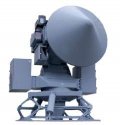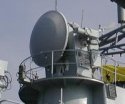Yes, thats chengdu(120) sitting there since end of july..The 052D on the bottom of the Dalian shipyard image is on the pier for processing outward ships. Means its done and is just awaiting for paperwork for delivery.
You are using an out of date browser. It may not display this or other websites correctly.
You should upgrade or use an alternative browser.
You should upgrade or use an alternative browser.
055 DDG Large Destroyer Thread
- Thread starter FarkTypeSoldier
- Start date
- Status
- Not open for further replies.
asif iqbal
Banned Idiot
So now Type 055 launches in 2019?
We have 2 identified at DL
And 2 at JNCX
8 in total

We have 2 identified at DL
And 2 at JNCX
8 in total

williamhou
Junior Member
An August update from satellite...

A high-resolution magazine scan... A similar image was shared before.

Looks like the CIWS is installed so low that it would destroy the main gun in the event of a head-on incoming missile. Wonder if the control software would allow the CIWS to fire at all in that situation.
It is not the first DDG they have this issue, but it seems they are not bothered by the inefficiencies in CIWS placement.
Last edited:
Looks like the CIWS is installed so low that it would destroy the main gun in the event of a head-on incoming missile. Wonder if the control software would allow the CIWS to fire at all in that situation.
It is not the first DDG they have this issue, but it seems they are not bothered by the inefficiencies in CIWS placement.
They should have the software done for that, plus the stealth designed main gun blocks and deflects away the threat radar from the non stealthy CIWS, reducing the frontal RCS of the ship. Plus the main gun would also be firing at the incoming missile directly.
One should question the inefficiencies of programming and targeting for the guidance of the antiship missile if you decide to target the front of the ship head on. Hitting the bow of the ship would likely mean the missile is going to bounce off from it.
lcloo
Major
I once read an article on CJDBY on using the main gun like a shot gun, i.e. shooting a shell that burst into hundreds of sub-munition towards a incoming anti-ship missile. Though we have no photo evidence and lack of information on this particular shell on Chinese side, but such bee-hive shells do exist in other armed forces.
Also, it is impossible for Chinese naval designer to over-look the height of the CIWS against the main deck gun. The shells from the CIWS do not travel in straight lines, due to pull of gravity, all bullets and shells fly in an arch down towards the ground or the sea surface. In theory they can elevate the CIWS barrels a few degree upwards to avoid the main deck gun, and shoot at target at maximum range. Software control helps.
Also, it is impossible for Chinese naval designer to over-look the height of the CIWS against the main deck gun. The shells from the CIWS do not travel in straight lines, due to pull of gravity, all bullets and shells fly in an arch down towards the ground or the sea surface. In theory they can elevate the CIWS barrels a few degree upwards to avoid the main deck gun, and shoot at target at maximum range. Software control helps.
SamuraiBlue
Captain
I once read an article on CJDBY on using the main gun like a shot gun, i.e. shooting a shell that burst into hundreds of sub-munition towards a incoming anti-ship missile. Though we have no photo evidence and lack of information on this particular shell on Chinese side, but such bee-hive shells do exist in other armed forces.
Also, it is impossible for Chinese naval designer to over-look the height of the CIWS against the main deck gun. The shells from the CIWS do not travel in straight lines, due to pull of gravity, all bullets and shells fly in an arch down towards the ground or the sea surface. In theory they can elevate the CIWS barrels a few degree upwards to avoid the main deck gun, and shoot at target at maximum range. Software control helps.
Most artillery shells should have a proximity fuse embedded which explodes the shell into shard shrapnel into incoming projectiles.
The question is, are artillery shells fast enough to engage with the incoming missiles?
I once read an article on CJDBY on using the main gun like a shot gun, i.e. shooting a shell that burst into hundreds of sub-munition towards a incoming anti-ship missile. Though we have no photo evidence and lack of information on this particular shell on Chinese side, but such bee-hive shells do exist in other armed forces.
Also, it is impossible for Chinese naval designer to over-look the height of the CIWS against the main deck gun. The shells from the CIWS do not travel in straight lines, due to pull of gravity, all bullets and shells fly in an arch down towards the ground or the sea surface. In theory they can elevate the CIWS barrels a few degree upwards to avoid the main deck gun, and shoot at target at maximum range. Software control helps.
AA artillery shells and SAMs contain proximity fuse and HE-FRAG as standard practice since the day they were invented.
Both radar and software helps. Software as in motion and track prediction for example.
The basics.
Your fire control radar is also important for this. With PLAN ships its easy who does this, being the Type 344 radar that resembles, and maybe related to the Thales STIR that you see in many warships in the West. This has a kind of disk shape like this.


But the Type 055 lacks this, and should have substituted this with any of those AESAs on top of the bridge or on the mast. That is one of the mysteries in the ship.
FCRs shown above have EOs and laser rangefinding, and we can account for EOs in PLAN ships, there is a potential opening for an EO in the 055 mast.
Last edited:
PLAN may thus have more confidence in their 130mm gun's anti-missile capability as part of layer defence than some of our members here. Is that right?
At 40 rounds per minute, that's double the rate of a Mk.45, and the H/PJ-38 has PGM munitions the AK-130 doesn't have, so yes, there should be plenty of AA potential there and certainly the intention for such.
I do wonder in my mind what controls it though, lacking the Type 344 FCRs you see on the 052C/D. Does the Type 346B arrays control the guns, or does it pass it to another radar? If its the small four paneled radar on top of the mast, which would have to be an X-band if it has gunnery functions, from its high point the radar would have an expanded radio horizon, which means it can engage a threat before the CIWS can. If this X-band AESA handles the FCR for the main gun, it can spot, track and engage the threat before the CIWS can and at a range greater than it. I have not taken the labor of measuring the height of this radar vs. the height of the Type 344, but my impression is that this new radar has a higher height than the 344 as it sits on the 052C/D, which itself sits pretty high to clear the Type 366 Bandstand radar's dome.
Refer to Page 700, post #6993 by by78, that confirms the panels on the top mast are radars, having a circular-hexagonal array shaped, and which were newly installed.
Last edited:
- Status
- Not open for further replies.

